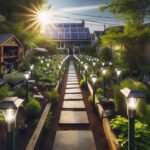Imagine transforming your garden into a sustainable paradise powered by the sun. While the idea of a solar-powered garden sounds appealing, many enthusiasts make crucial mistakes that can derail their plans. Did you know that nearly 70% of people underestimate the importance of proper planning when switching to solar energy?
What if you could avoid common pitfalls and create a thriving, energy-efficient garden? Understanding the steps to take—and the mistakes to avoid—can make all the difference in your journey towards sustainability. Jump into this guide to uncover essential tips that will help you navigate the transition smoothly and maximize your garden’s potential.
Common Misconceptions About Solar Power
Transitioning to solar energy often brings misconceptions that can lead you astray. Understanding these common myths is crucial in creating a sustainable solar-powered garden.
Understanding Solar Energy
Solar energy isn’t just for sunny days. Many believe solar panels won’t work effectively in cloudy weather, but that’s not the case. In fact, solar panels can generate electricity even with limited sunlight. They convert diffuse light into usable energy, providing a dependable power source throughout different seasons. Isn’t it reassuring to know that you can embrace a solar lifestyle even though Canada’s variable weather?
 Top 10 best solar powered watches for sustainable timekeeping
Top 10 best solar powered watches for sustainable timekeepingDebunking Myths
Several myths about solar panels persist, often deterring individuals from making the switch. One prevalent myth is the belief that solar panels are too costly with little return on investment. While initial costs exist, the long-term savings from reduced energy bills significantly outweigh these costs. Think of your investment in solar panels as a pathway to energy independence. You can reap benefits not just in savings but in environmental impact too.
So, why let myths cloud your decision? Educating yourself about the realities of solar energy is essential. Dive deeper into how solar panels for life can transform not just your garden, but your whole energy consumption. Ready to explore more?
Planning Your Solar-Powered Garden
Planning is crucial when transitioning to a solar-powered garden. Many individuals underestimate the significance of this step, only to face setbacks later on. A well-structured plan minimizes mistakes and sets the stage for successful solar integration.
Assessing Your Garden Space
Assess your garden space first. Think about the layout, sunlight exposure, and the locations of obstacles like trees or buildings. Does your garden receive ample sunlight? Ideally, solar panels get direct sunlight for six to eight hours daily for optimal performance. If your garden’s shaded, consider how you can trim back foliage or even reposition plants to enhance solar access.
Read also: Top 10 best solar powered watches for sustainable timekeeping
Top 10 best solar powered watches for sustainable timekeeping Extending Battery Life on Solar Backpacking Trips
Extending Battery Life on Solar Backpacking TripsNext, visualize where you want to install solar panels, lights, or even fountains powered by solar energy. Don’t forget to evaluate your energy needs. Conduct an energy audit on existing equipment; this gives you a clearer picture of how many solar panels you require. After your assessment, you’re ready to create a layout that maximizes solar efficiency and aesthetic appeal.
Choosing the Right Solar Products
Choosing the right solar products impacts your garden’s effectiveness and aesthetic. Start with solar panels designed for garden use. Small, efficient panels may work if you plan to power lights or small fountains. Look into integrated solar products, as they combine function with design. For instance, solar path lights can line walkways while reducing energy costs.
Consider the quality and warranty of solar products—investing in reliable items translates to long-term savings. Evaluating product specifications compared to your energy needs can lead to significant gains. Are you ready to embrace the solar lifestyle? Explore options that suit your garden’s unique needs while keeping aesthetics in mind.
Installation Mistakes
When transitioning to a solar-powered garden, avoiding common installation mistakes is crucial for maximizing your solar investment and achieving a beautiful, functional world.
Read also: Top 10 best solar powered watches for sustainable timekeeping
Top 10 best solar powered watches for sustainable timekeeping Extending Battery Life on Solar Backpacking Trips
Extending Battery Life on Solar Backpacking Trips Experience a solar powered festival: top reasons to go green
Experience a solar powered festival: top reasons to go greenImproper Placement of Solar Panels
Proper placement of solar panels makes all the difference. Position them in areas with maximum sunlight exposure rather than spots that might seem convenient. Are you ignoring the angles? Panels placed flat or against structures may not capture optimal sunlight. Think about it: if solar panels don’t receive sufficient light, your energy output will plummet. Consider using adjustable mounting systems to optimize angles throughout the year.
Incorporating solar panels in the right locations enhances both energy efficiency and your garden’s aesthetic appeal. This aligns with a solar lifestyle where every element works together harmoniously. If you’re unsure about the ideal positioning, professional consultation offers clarity and guidance.
Neglecting Shade Factors
Shade can be a silent enemy when it comes to solar energy. Are trees, buildings, or other structures casting shadows on your solar panels? It’s critical to conduct a thorough shade analysis before installation. Even a small amount of shade during peak sunlight hours can significantly reduce panel performance.
When you assess your garden space, consider the variability of shade throughout different seasons. Will those gorgeous, mature trees block sunlight in summer? Understanding these dynamics ensures your panels generate energy consistently. Installing your panels in well-lit areas guarantees solar energy works effectively, complementing your sustainable garden vision. Explore your options wisely; the right choices today lead to a successful solar journey.
Read also: Top 10 best solar powered watches for sustainable timekeeping
Top 10 best solar powered watches for sustainable timekeeping Extending Battery Life on Solar Backpacking Trips
Extending Battery Life on Solar Backpacking Trips Experience a solar powered festival: top reasons to go green
Experience a solar powered festival: top reasons to go green How to maintain and extend the life of your solar lights easily
How to maintain and extend the life of your solar lights easily